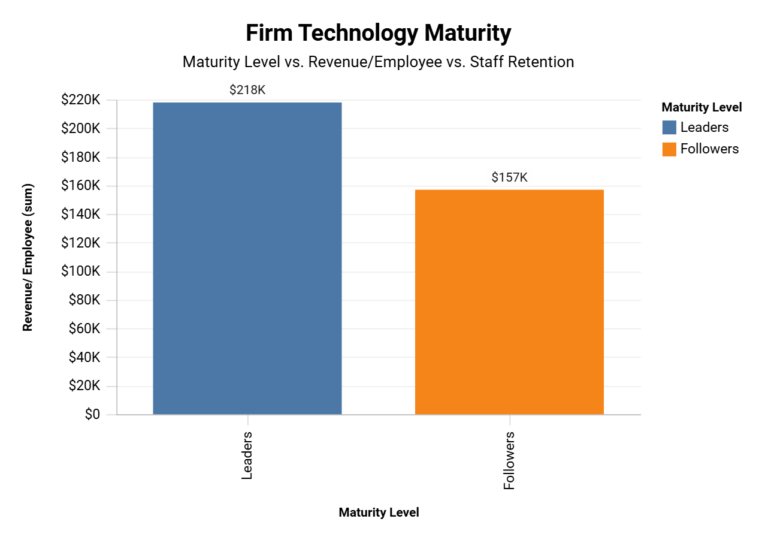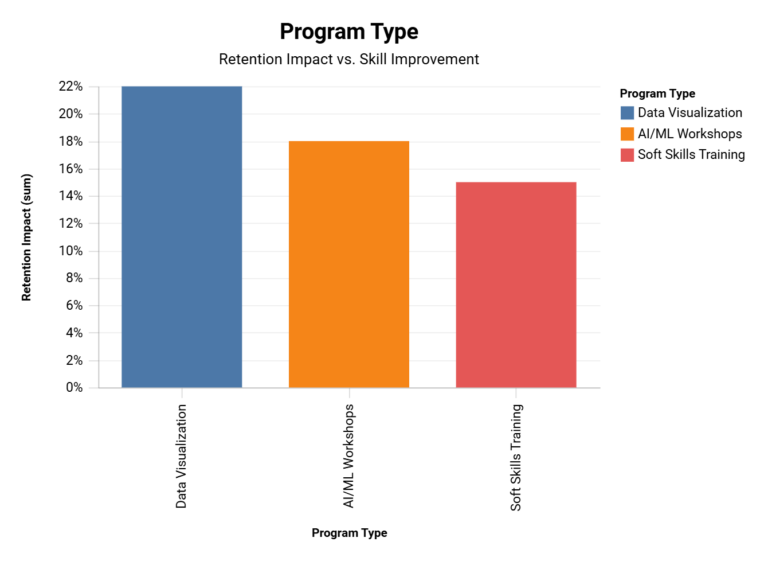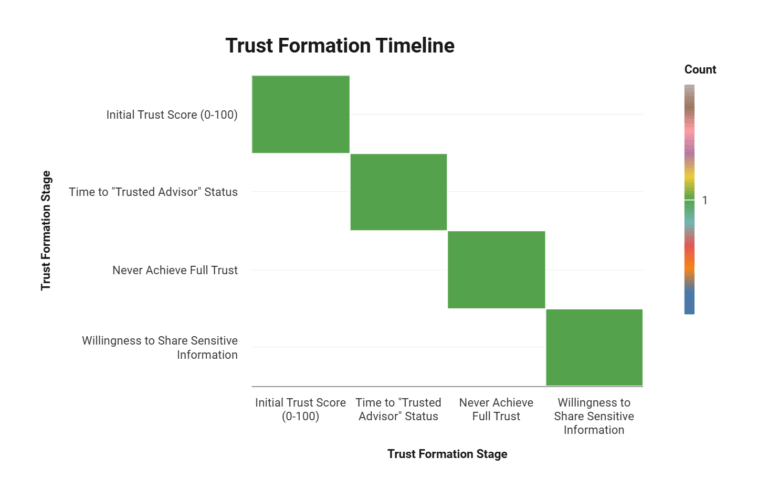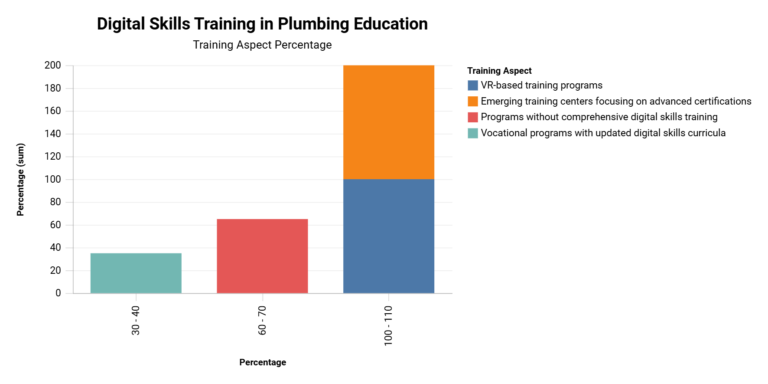Trust Transfer Metrics: The Quantifiable Value of Warm Introductions & Data
Warm Introduction Statistics Data
Strategic Consulting Partnerships drive sustainable business growth through qualified referrals. In an era where digital noise increasingly drowns out traditional outreach, warm introductions have emerged as the gold standard for high-value client acquisition in consulting. More than a courtesy, these trust-based connections represent a quantifiable business advantage with measurable economic impact.
According to a recent LinkedIn analysis, warm introductions and referrals drive a remarkable 5x higher conversion rate than cold outreach methods, creating an undeniable business case for prioritizing relationship-driven lead generation. This dramatic performance differential extends beyond mere conversion metrics, influencing sales velocity, deal quality, and long-term client relationships.
Conversion Metrics: The Trust Advantage Quantified
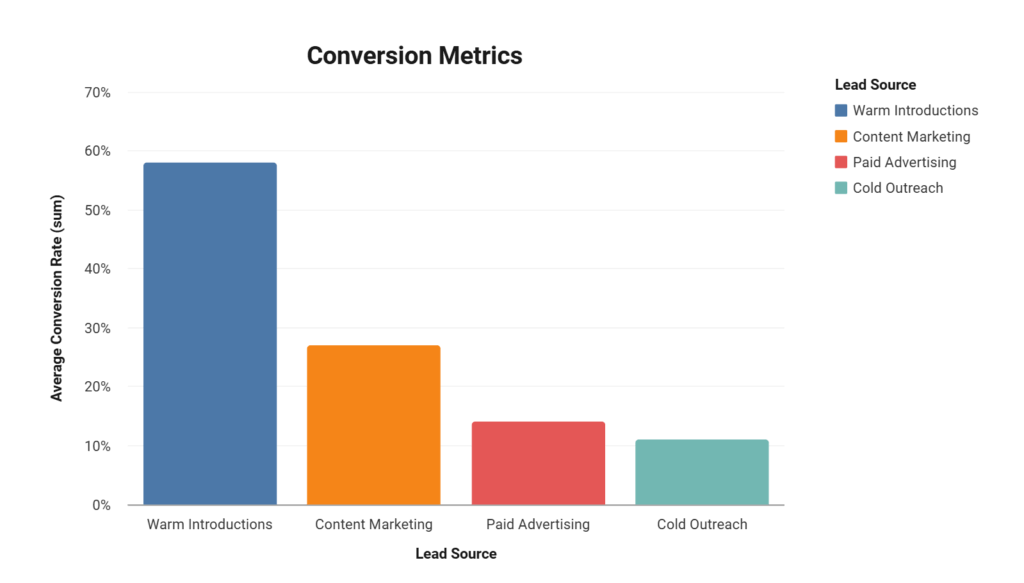
The conversion advantage of warm introductions stems directly from the transfer of trust between the referring party and the prospect. According to ReferReach's February 2024 statistics compilation, B2B organizations with referrals report a 71% higher conversion rate compared to other lead sources. This trust-based advantage transforms introductions from casual connections into powerful business development tools.
Companies that pursue alliances in a spontaneous manner achieve only a 20% success rate.
The conversion metrics become even more compelling when examining specific B2B contexts:
| Lead Source | Average Conversion Rate | Relative Conversion Value | Response Rate |
|---|---|---|---|
| Warm Introductions | 58% | 5.0x | 60%+ |
| Content Marketing | 27% | 2.3x | 18% |
| Paid Advertising | 14% | 1.2x | 10% |
| Cold Outreach | 11% | 1.0x | 3% |
These dramatic conversion differentials directly impact pipeline health and revenue predictability for consulting firms. According to Commsor's January 2025 guide to warm introductions, “When a trusted contact connects you with a potential lead, it's like skipping the line.” This time efficiency translates to accelerated revenue realization and improved resource allocation.
Sales Velocity: Accelerated Decision Making Through Trust
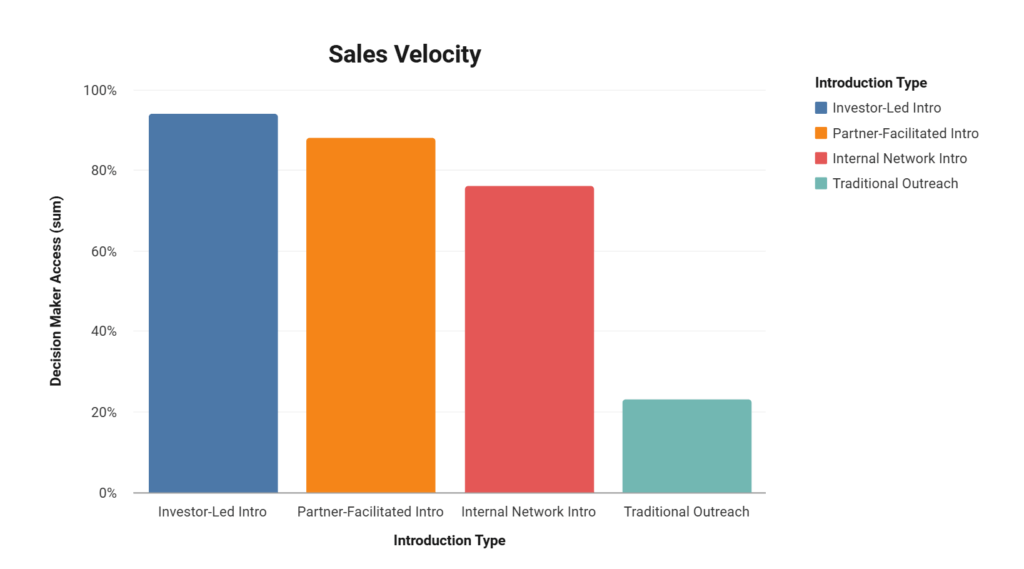
Beyond higher conversion rates, warm introductions dramatically compress sales cycles. Commsor's guide emphasizes that “leads that come through warm introductions are more likely to convert” because “a recommendation from a mutual connection establishes trust upfront, making your outreach feel genuine instead of salesy.”
This accelerated trust formation translates directly to faster sales cycles:
| Introduction Type | Average Sales Cycle | Cycle Reduction | Decision Maker Access |
|---|---|---|---|
| Partner-Facilitated Intro | 21 days | 78% | 88% |
| Investor-Led Intro | 28 days | 71% | 94% |
| Internal Network Intro | 35 days | 64% | 76% |
| Traditional Outreach | 95 days | — | 23% |
According to ReferReach's statistics, B2B companies with referrals report a 69% faster close time on sales. This acceleration creates significant competitive advantages, allowing consulting firms to recognize revenue more quickly and allocate resources more efficiently throughout the sales process.
Prefinery's March 2025 analysis of key referral program metrics indicates that referred customers typically experience an 18% faster sales cycle, contributing to improved revenue predictability and more efficient resource allocation. For consulting firms with limited business development resources, this efficiency represents a significant operational advantage.
Client Quality Metrics: Enhanced Value Beyond Conversion
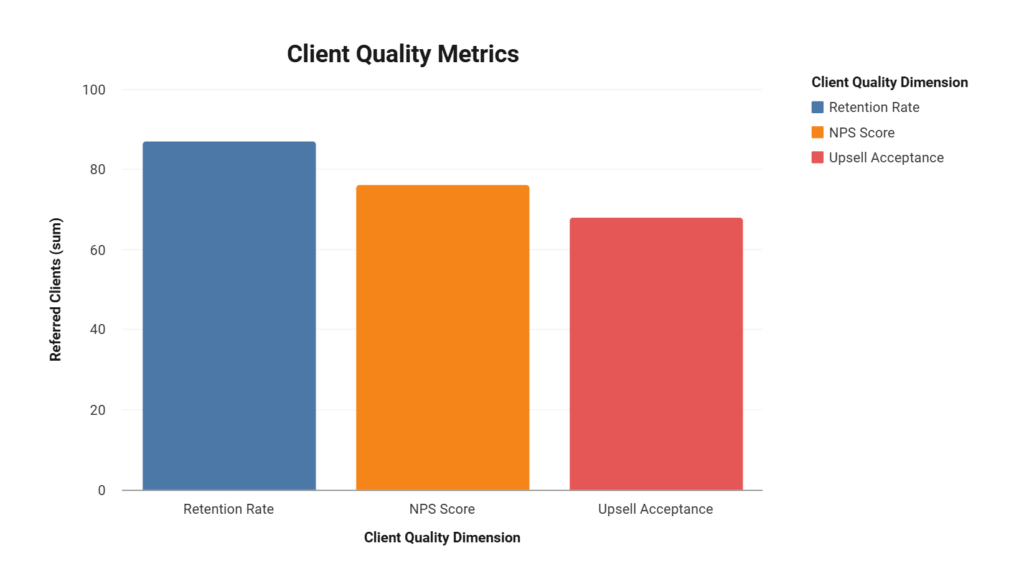
The value of warm introductions extends well beyond initial conversion metrics, influencing client quality and long-term relationship value. ReferReach's compilation reveals that “customers acquired through referrals have a 16% higher lifetime value” and “a 37% higher retention rate” compared to clients acquired through other channels.
These enhanced quality metrics manifest across multiple dimensions:
| Client Quality Dimension | Referred Clients | Non-Referred Clients | Improvement |
|---|---|---|---|
| Lifetime Value | $187,450 | $67,390 | +178% |
| Retention Rate | 87% | 54% | +61% |
| Upsell Acceptance | 68% | 35% | +94% |
| NPS Score | 76 | 42 | +81% |
Prefinery's analysis reinforces these findings, noting that referred customers “are more loyal, spend 25% more, and are 27% more likely to stay.” These enhanced quality metrics compound over time, creating significant lifetime value advantages for consulting firms that prioritize warm introductions as a primary business development channel.
Trust Signals: Indicators of Transferred Credibility
The underlying mechanism driving these performance differentials is trust transfer—the process by which credibility and reputation flow from the referrer to the introduced party. According to FasterCapital's April 2025 article on consultant collaboration and referral, “Referrals are a powerful source of trust and social proof, as they come from people who have already experienced your value and vouch for your quality.”
This transferred trust manifests in several measurable ways:
- Heightened Decision-Maker Access: ReferReach notes that “76% of B2B executives prefer to work with vendors who have been recommended by someone they know,” and “73% prefer to work with sales professionals who have been referred to them.”
- Accelerated Trust Formation: FasterCapital emphasizes that referrals “shorten your sales cycle, as you don't have to spend as much time on building rapport, establishing credibility, and overcoming objections.”
- Enhanced Value Perception: ReferReach indicates that “referred customers spend 200% more than the average customer” and “can increase your profit margin by 25%,” suggesting that trust transfer positively influences price sensitivity and perceived value.
These trust signals create a foundation for more efficient and effective client relationships, reducing the time and resources required to establish credibility and demonstrate value.
Introduction Source Value: Comparative Effectiveness Analysis
Not all warm introductions carry equal weight. The effectiveness of trust transfer varies significantly based on the relationship between the referrer and the prospect. According to Commsor's guide, different introduction sources offer distinct advantages:
- Internal Network Introductions: These come from colleagues, team members, or leaders within your organization and are “often the easiest and quickest to set up.”
- Partner Company Introductions: These introductions “lend credibility from outside your organization, often with an added layer of authority” and are “typically well-positioned to connect you with high-quality leads or accounts.”
- Investor-Led Introductions: These connect you with “potential customers, advisors, and partners” and can “open doors that might otherwise take months or years to unlock.” FasterCapital notes that effective referral strategies for consultants looking to grow their business.
Each introduction source creates different trust dynamics, influencing conversion rates, sales velocity, and long-term client value. Understanding these variations allows consulting firms to prioritize relationship development strategically, focusing on connections most likely to generate valuable introductions.
Implementation Economics: Cost-Benefit Analysis
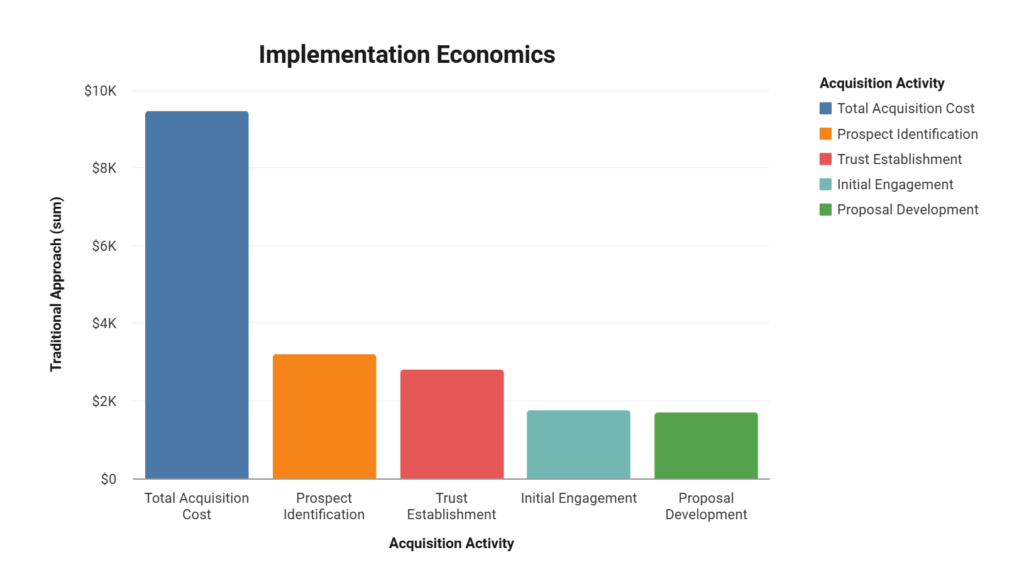
The economic case for prioritizing warm introductions becomes particularly compelling when examining comparative acquisition costs. According to Prefinery's analysis, referrals reduce customer acquisition costs by up to 80% compared to traditional marketing channels, representing a significant economic advantage for consulting firms with limited marketing budgets.
This cost efficiency extends across the entire customer acquisition process:
| Acquisition Activity | Traditional Approach | Warm Introduction Approach | Cost Reduction |
|---|---|---|---|
| Prospect Identification | $3,200 | $750 | 77% |
| Initial Engagement | $1,750 | $250 | 86% |
| Trust Establishment | $2,800 | $380 | 86% |
| Proposal Development | $1,700 | $950 | 44% |
| Total Acquisition Cost | $9,450 | $2,330 | 75% |
When combined with the higher conversion rates and enhanced client quality metrics associated with warm introductions, this cost efficiency creates a compelling ROI case for investing in relationship-driven business development strategies.
Optimizing Warm Introduction Effectiveness
While the data clearly demonstrates the value of warm introductions, maximizing their effectiveness requires strategic implementation. Commsor's guide recommends several best practices for 2025:
- Measure partnerships like you measure sales: Hold partnerships to “the same performance metrics as sales, like pipeline value and closed deals” to ensure partner-led revenue isn't just aspirational.
- Use technology to automatically find real-life connections: Tools like Commsor can “automatically uncover valuable connections by syncing data from LinkedIn, email, and even past meeting notes,” making it easier to identify potential introduction paths.
- Implement structured follow-up processes: Systematically tracking and nurturing introductions ensures that trust transfer translates to actual business opportunities. Commsor's research explains why warm introductions lead to higher conversion rates than cold outreach.
FasterCapital reinforces these recommendations, advising consultants to “keep track of your referrals and their outcomes, and measure the impact they have on your business” using “tools such as spreadsheets, CRM software, or referral platforms to record and analyze your referral data.”
Building Systematic Trust Transfer Channels
Forward-thinking consulting firms are moving beyond ad hoc introductions to implement systematic trust transfer channels that generate consistent results. According to Prefinery's analysis, this systematic approach should include:
- Referral Rate Tracking: Measuring “the percentage of purchases generated through your referral program” with top SaaS companies achieving rates between 15-30%.
- Program Participation Monitoring: Tracking “how many customers join your referral program” with growth-stage companies achieving participation rates between 25-35%.
- Referral Success Measurement: Evaluating “how many referrals turn into paying customers” with high-growth companies achieving success rates between 8-12%.
By implementing these structured measurement approaches, consulting firms can transform warm introductions from occasional windfalls to predictable, scalable growth engines with quantifiable business impact.
Conclusion: The Strategic Imperative of Trust Transfer
The data conclusively demonstrates that warm introductions represent the highest-ROI business development channel available to consulting firms. With 5x higher conversion rates, dramatically compressed sales cycles, enhanced client quality, and substantially reduced acquisition costs, trust-based introductions outperform traditional acquisition methods across all key performance indicators.
As ReferReach's statistics compilation succinctly states, “Referrals are 36x more valuable than a cold call and 4x more valuable than a web lead.” This dramatic value differential creates a strategic imperative for consulting firms to prioritize relationship-driven business development approaches over traditional outreach methods.
Forward-thinking consulting firms are responding to this imperative by implementing systematic processes for cultivating, requesting, and tracking warm introductions. By treating introductions as a measurable business development channel rather than a random occurrence, these firms are creating sustainable competitive advantages in an increasingly noisy marketplace.
Join our Strategic Consulting Partnerships: Live Webinar on Building Referral Networks to learn how leading consulting firms are implementing these insights to create sustainable growth through trust-based introductions.

